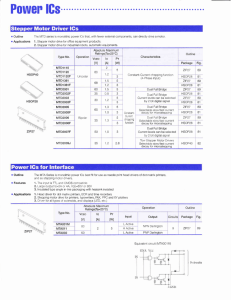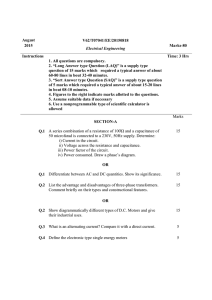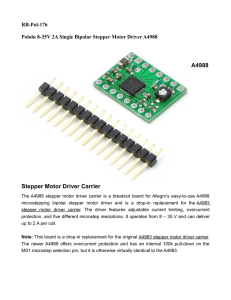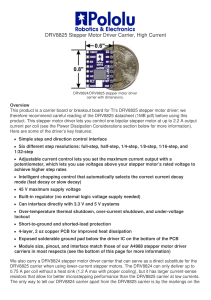A4983 Stepper Motor Driver Carrier with Voltage Regulators
advertisement
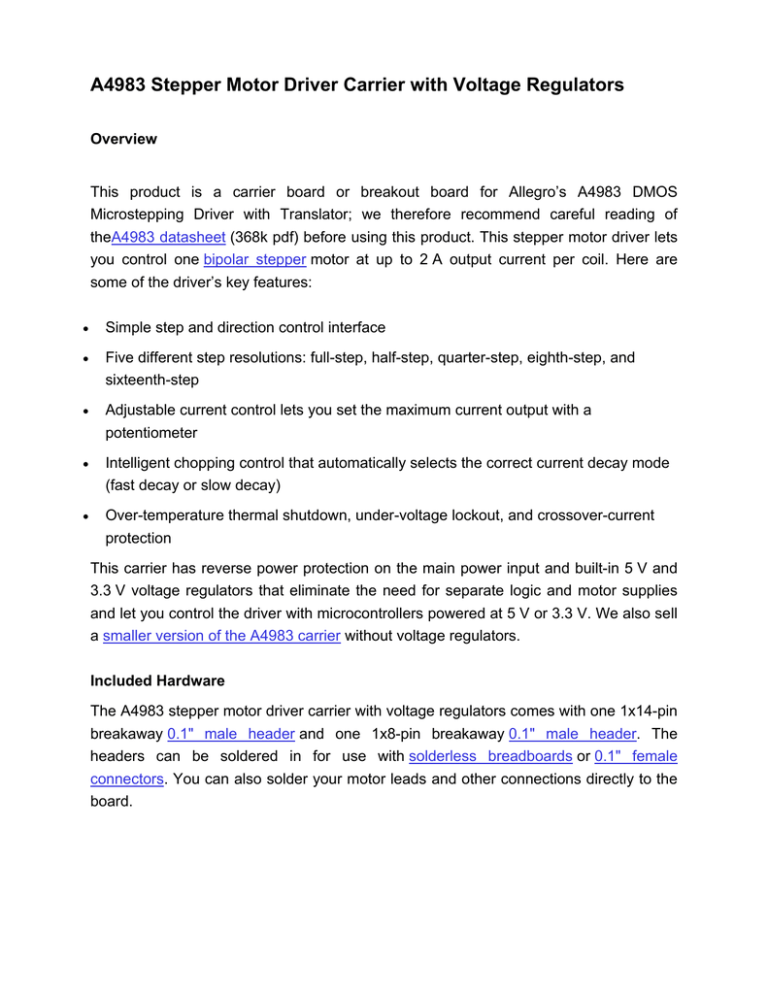
A4983 Stepper Motor Driver Carrier with Voltage Regulators Overview This product is a carrier board or breakout board for Allegro’s A4983 DMOS Microstepping Driver with Translator; we therefore recommend careful reading of theA4983 datasheet (368k pdf) before using this product. This stepper motor driver lets you control one bipolar stepper motor at up to 2 A output current per coil. Here are some of the driver’s key features: • Simple step and direction control interface • Five different step resolutions: full-step, half-step, quarter-step, eighth-step, and sixteenth-step • Adjustable current control lets you set the maximum current output with a potentiometer • Intelligent chopping control that automatically selects the correct current decay mode (fast decay or slow decay) • Over-temperature thermal shutdown, under-voltage lockout, and crossover-current protection This carrier has reverse power protection on the main power input and built-in 5 V and 3.3 V voltage regulators that eliminate the need for separate logic and motor supplies and let you control the driver with microcontrollers powered at 5 V or 3.3 V. We also sell a smaller version of the A4983 carrier without voltage regulators. Included Hardware The A4983 stepper motor driver carrier with voltage regulators comes with one 1x14-pin breakaway 0.1" male header and one 1x8-pin breakaway 0.1" male header. The headers can be soldered in for use with solderless breadboards or 0.1" female connectors. You can also solder your motor leads and other connections directly to the board. Using the driver Power connections The driver requires a logic supply voltage (3 – 5.5 V) to be connected across the VDD and GND pins and a motor supply voltage of (8 – 35 V) to be connected across VMOT and GND. The logic voltage can be supplied by jumpering the output of the 5 V or 3 V voltage regulator outputs to VDD. There are also surface-mount pads that allow VDD selection to be made by making a solder bridge across the appropriate pads. The power supply should be capable of delivering the expected currents (peaks up to 4 A for the motor supply). Step (and microstep) size Stepper motors typically have a step size specification (e.g. 1.8° or 200 steps per revolution), which applies to full steps. A microstepping driver such as the A4983 allows higher resolutions by allowing intermediate step locations, which are achieved by energizing the coils with intermediate current levels. For instance, driving a motor in quarter-step mode will give the 200-step-per-revolution motor 800 microsteps per revolution by using four different current levels. The resolution (step size) selector inputs (MS1, MS2, MS3) enable selection from the five step resolutions according to the table below. MS1, MS2 and MS3 all have internal 100kΩ pull-down resistors. For the microstep modes to function correctly, the current limit must be set low enough (see below) so that current limiting gets enganged. Otherwise, the intermediate current levels will not be correctly maintained, and the motor will effectively operate in a full-step mode. MS1 MS2 MS3 Microstep Resolution Low Low Low Full step High Low Low Half step Low High Low Quarter step High High Low Eighth step High High High Sixteenth step Control inputs Each pulse to the STEP input corresponds to one microstep of the stepper motor in the direction selected by the DIR pin. The chip has three different inputs for controlling its many power states: RST, SLP, and EN. For details about these power states, see the datasheet. Current limiting To achieve high step rates, the motor supply is typically much higher than would be permissible without active current limiting. For instance, a typical stepper motor might have a maximum current rating of 1 A with a 5Ω coil resistance, which would indicate a maximum motor supply of 5 V. Using such a motor with 12 V would allow higher step rates, but the current must actively be limited to under 1 A to prevent damage to the motor. The A4983 supports such active current limiting, and the trimmer potentiometer on the board can be used to set the current limit. An easy way to set the current limit is to put the driver into full-step mode and to measure the supply current to the board without clocking the STEP input. The measured current will be 1.4 times the current limit (since both coils are always on and limited to 70% in full-step mode). Another way to set the current limit is to measure the voltage on the REF pin and to calculate the resulting current limit (the current sense resistors are 0.05Ω). Schematic Diagram



